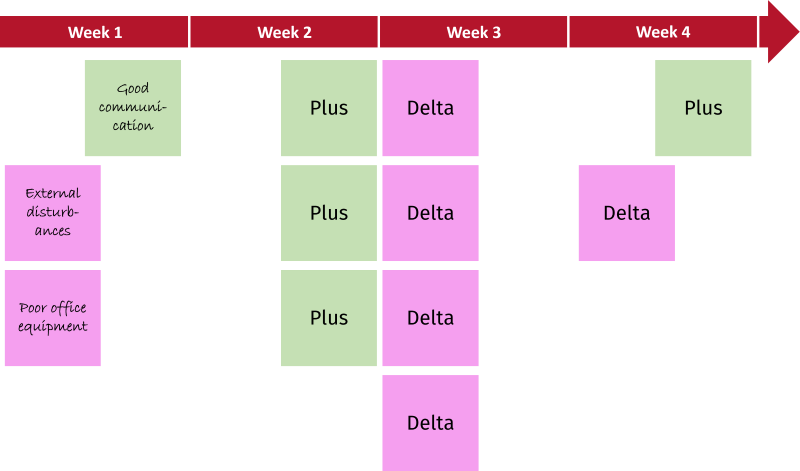Theory "Sprint Retrospective"
Feedback on the previous Sprint¶
After the Sprint Review Meeting has taken place, i.e. after the Developers have presented the potentially deliverable Increment to the Product Owner and the Stakeholders, the Sprint Retrospective follows. This can literally take place directly after the Sprint Review. Just like the Sprint Review, the Sprint Retrospective is convened by the Scrum Master. He is responsible for ensuring that the Sprint Retrospective takes place and that all Developers and the Product Owner are informed about the time and place.
The Sprint Retrospective, which is held at the end of each Sprint, can be seen as a counterpart to the Sprint Review: while in the Sprint Review Meeting the Increment is reviewed and the Developers receive feedback from the Product Owner and the stakeholders, the Sprint Retrospective is a meeting in which the focus is on the way of working. It is the Developers' turn at this point to give feedback on the Sprint itself. It primarily serves the Developers to improve productivity and processes, but the entire Scrum Team can also benefit from the Sprint Retrospective.
Safe space for feedback
During the Sprint Retrospective, the focus is on the entire team of Developers - no individual Developer is pointed out in a positive or negative way. Feedback plays a central role during the Sprint Retrospective and every Scrum Team member should be encouraged to give honest feedback.
Lessons learned and continuous improvement¶
During the Sprint Retrospective, the past Sprint is reviewed to see to what extent the process was trouble-free and what can be improved for future Sprints. The Developers should ask themselves the following questions:
- What went well during the Sprint?
- What was less successful during the Sprint?
- How can we improve?
These questions can be used to find out where the problem areas were and the identified problems can be tackled and ideally solved. How to solve the problems and how to improve the quality should also be worked out during the Sprint Retrospective. If desired, the Sprint improvement items can be included in the Sprint Backlog of the next Sprint. If there have been changes to the framework during the Sprint or if Scrum Team members feel that the Definition of Done needs to be adjusted, the Sprint Retrospective is the right meeting to talk about it.
The Sprint Retrospective must take place
Since the Sprint Retrospective is an official Scrum Event, it has to take place in every Sprint of a Scrum project. Not doing so would mean that the project is not a continuous Scrum project, and the Scrum Team would also miss the opportunity to improve the qualification of the Developers. With each Sprint Retrospective, the Developers have the opportunity to look back on the previous Sprint and work out what went well and what went not so well. In this way, they can improve and increase the quality of the project Sprint by Sprint.
Schedule of the Sprint Retrospective¶
When conducting the Sprint Retrospective, it is a good idea to use the Plus-Deta method. This method aims to note everything from the Developers' point of view that went well (Plus) and where they see potential for improvement (Delta).

The process could look as follows:
-
The agenda for the Sprint Retrospective is set and accepted by a show of hands.
-
The timeline of the past Sprint is presented with the help of post-it notes.
-
Specific points are then marked on this timeline with plus and delta cards.
-
The Developers note on the plus cards what they think went well and on the delta cards where they see potential for improvement.
-
The results of these labelled areas are discussed.
-
Changes and improvements to be made for the next Sprint or impediments (infrastructure, attempts at interference from outside, improvements for the performance of the Developers, etc.) are identified.
-
Action items, responsible persons and deadlines for completion are defined.
Overview: Sprint Retrospective
- Participants: Scrum Team
- Moderation by the Scrum Master
- Duration: Maximum 3 hours
- Result: Reflection on the previous Sprint and clarification of the question, how it went and where there is room for improvement.